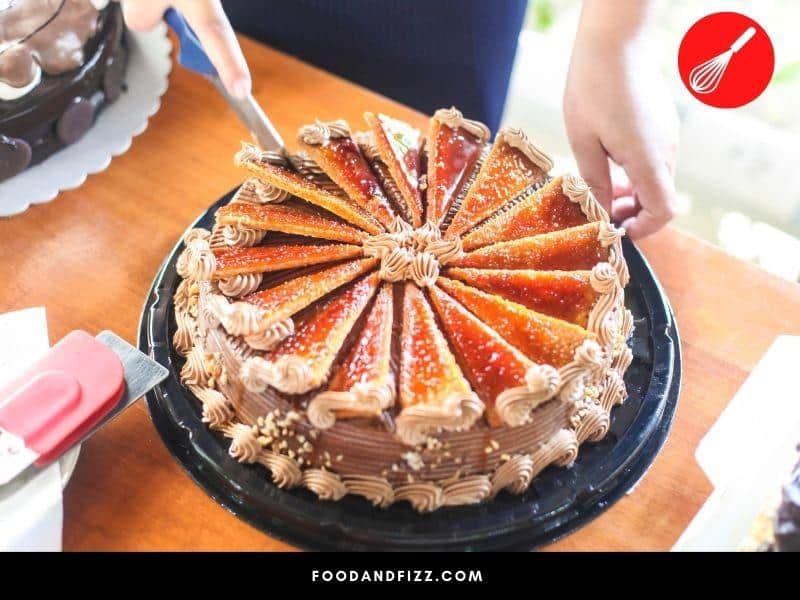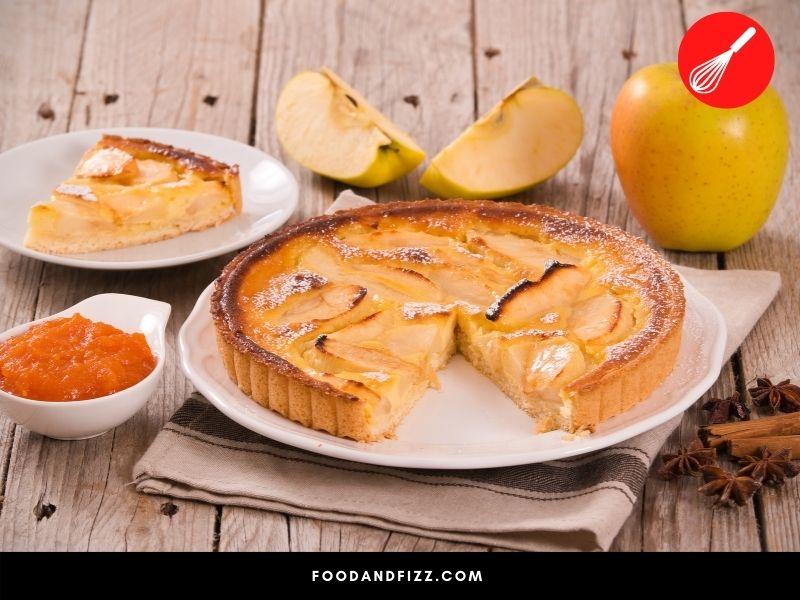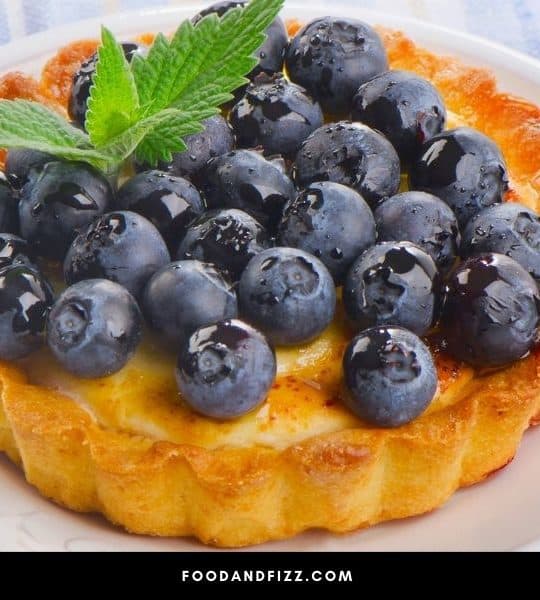A torte and a tart may sound similar and it’s easy to assume that they’re just two names for the same thing, perhaps referring to sweet treats that most of us look forward to after a meal.
But tortes and tarts are actually different things, and it would help to know just what their differences are for the next time you visit your favorite bakery.
Torte vs Tart – What is the Difference?
Torte vs Tart. A torte is a rich, layered sweet cake made mostly of eggs, ground nuts, or breadcrumbs and contains very little to no flour. It is denser and richer compared to regular cake, but it is also filled with an assortment of fillings and frostings. A tart looks very similar to a pie except that it is not covered and while usually sweet, it can be savory as well. Tart crusts are thicker and crumblier compared to pies, and their fillings are more delicate, usually unbaked or lightly baked.

Torte vs Tart – What is the Difference?
While their names may sound similar, tortes and tarts could not be more different. In terms of form, tortes are more similar to cakes (it is a type of cake after all), while tarts more closely resemble and in fact can even be confused with pies.
Tortes, like most cakes, are multi-layered (Read: How Many Boxes of Cake Mix For A Three Layer Cake?) and are frosted with various fillings like fruit, cream, chocolate, and nuts, and if you didn’t know any better, you would just assume it is just like any other normal cake.
Tarts have thick crusts with shallow borders, that are filled with either sweet or savory fillings but are not covered with an additional sheet of dough on top as what would normally happen for pies (although some pies can be uncovered, too).
For the common person without knowledge of the technical differences in pastry dough used for a tart and a pie, a tart would just look like a regular pie, albeit with shallower edges.
Tortes are said to have originated in Central Europe; from Austria, Germany, or Hungary, while Tarts have their origins in France.
All About Tortes – A Closer Look
What is a Torte?
A torte is a type of cake that is said to have come from Central Europe. Unlike regular cake, flour does not feature a prominent role in making tortes. Most tortes use only a small amount of flour, if at all.
Instead of flour, eggs, ground nuts, and bread crumbs are used to create multiple layers that are then assembled and filled with various types of rich fillings to create a look that would almost be indistinguishable from a regular cake, until you’ve had a taste.

Tortes vs Cakes
So, what’s the difference between tortes and cakes? We’ll explore key differences below.
1. Ingredients Used
The basic ingredients of cake are usually flour, sugar, salt, fat, eggs, and liquid. Depending on the ratio of ingredients and type of flour used, they produce cakes in varying degrees of lightness. Tortes use very little flour, if any, and rely instead on ground nuts or breadcrumbs to replace the flour.
2. Height of Layers
Tortes, because of the nature of the ingredients used, tend to have shorter layers and denser and heavier textures compared to a regular cake.
They do not rise as much, that is why it’s common for tortes to have 3-4 layers but still look shorter or look just about the same height as a regular 2-layer cake. The ingredients used are heavier and therefore do not leaven as much.
3. Types of Fillings Used
Tortes also tend to be richer, because of the kind of fillings that are usually used. Fruit or jam fillings, ground nuts, whipped cream, mousses, or chocolate ganache are more commonly used, which can be heavier and richer compared to the lighter buttercreams and custard-type fillings of a typical cake.
Torte layers would also be sometimes brushed with or soaked in liquor-infused syrups for added moisture, which can result in them being denser and more filling.
So, there you have it, three basic things that can help distinguish tortes from the typical cake that we are used to seeing. Of course, those differences are not always clear-cut and can get blurred quite easily, especially in cases of fresh and new innovations in flavor combinations.
But traditionally speaking, the ingredients, fillings, and the feature of its layers would always distinguish tortes from the rest of their cake family.
The Most Famous Tortes
There are many different types of tortes and many different types of flavor combinations, but there are a few popular and iconic ones that have become an integral part of the cultures they have originated from. We’ll explore some of those here.
Sachertorte of Vienna
Arguably the most famous chocolate cake in the world, the Sachertorte was invented in Austria in 1832 by a 16-year-old apprentice chef named Franz Sacher.
The Austrian State Chancellor Prince Klemens Wenzel von Metternich wanted a dessert that will impress the pants out of his dinner guests, but it just so happened that the head chef got sick that day, and the extraordinary task was left to the young apprentice chef.
Apparently, he was one to rise to the challenge and was someone that can perform under extreme pressure (or perhaps he was already prepared for this for a long time and seized the opportunity to showcase his skills!), and unveiled the very first, the original Sachertorte that evening.
Much to the delight of the guests, and the chancellor, an iconic cake was born.
The Sachertorte is a dense, multilayered cake filled with apricot jam in between layers, and covered with a chocolate glaze icing. It is a staple cake in most Viennese coffee shops.
I’ve had the privilege of trying the most famous one at Hotel Sacher in Vienna a few years ago, and I must say, it truly is divine.

Schwarzwalder Kirschtorte of Germany
Also known as Black Forest Cake, this is one of the most well-known German desserts. Layers of chocolate cake are filled with whipped cream and cherries and sometimes topped with shaved chocolate.
Traditionally, a specialty liquor known as Schwarzwalder Kirsch, distilled from sour cherries, is added to the cake, giving it its distinct flavor.
Dobos Torte from Hungary
Very thin layers of buttery sponge cake, sometimes soaked in liquor, are filled with chocolate buttercream, topped with shiny, hardened caramel and sometimes covered in ground hazelnuts, chestnuts, or almonds. It is loved for its simplicity and elegance.
So there you have it, just a few of the more famous tortes that have captured the hearts (and tummies) of many around the world.
All About Tarts – A Closer Look
What is a Tart?
A tart is a shallow pastry filled with either sweet or savory fillings that can be baked or unbaked. It is similar in appearance to pie, but unlike pie, it only has a bottom crust.
Tarts are said to have originated in France, and the crust is typically made with traditional French shortcrust pastry dough. When made into small, miniature versions, they are called “tartlets”.
Tarts vs. Pies
If you see a tart in a pastry shop, especially when it is sitting next to a pie, you are not likely to even give it a second thought and would just probably think it was a type of pie.
It would be understandable, though, as they look pretty similar to each other.
The fact is, there are actually a number of differences between them. We’ll explore those below.
1. Form and Shape
Unlike pies that would usually have both a top covering and bottom crust, tarts only have a bottom crust (although there are some types of pie that do not have this top covering).
Tart crusts are thicker and crumblier while pie crust is usually thinner and flakier. Tarts are also shallower than pies and typically have straight sides.
While pies are usually served in the pan they are baked in, tarts are usually unmolded and served without the support of a pan.

2. Type of Dough Used for Crust
Tart crust is typically made from traditional shortcrust pastry doughs, which consists of flour, butter, water, and sometimes sugar.
Shortcrust doughs are called such because they require twice as much flour as they do fat. The resulting texture is more biscuit-like and will crumble more easily.
Pies, especially American-style pies like pumpkin pie (Read: “How To Tell if Pumpkin Pie is Done“), are made with dough that consists of similar ingredients: flour, butter, water, and salt, but the way that they are mixed and the proportions of the ingredients result in a flakier, airier crust.
3. Type of Filling
Both tarts and pies do well with sweet and savory fillings, but as tart shells are more delicate and shallower and may crumble more easily, and because they are unmolded and not served in a pan, they do well with fillings that are lighter like creams and custards.
Fillings that are too heavy may cause the shells to break apart, which isn’t too much of a problem with pies.
Tarts and pies are incredibly similar and one would be forgiven to mistake one for the other. But it would be good to know their specific technical differences to ensure that you choose the right method and ingredients the next time you make either one of them.
Well-Known Tarts
Tarts are popular the world over and you are likely to find a local version of a tart anywhere you go. We’ll mention some of the most famous ones below.
Tarte Normande
Tarte Normande or French Apple Tart is a classic tart that comes from the region of Normandy, known for its apples and apple brandy (known as Calvados).
The crust is made of pate brisee, a traditional French shortcrust pastry, and is usually served warm with crème Fraiche on the side.

Pastel de Nata
Pastel de Nata is a traditional Portuguese egg custard tart with a flaky crust and a rich but not too sweet filling that is sprinkled with cinnamon and powdered sugar.
The original and most famous one is called Pastel de Belem, originally created by monks at the Jeronimos Monastery in Santa Maria de Belem in Lisbon.
I’ve also had the privilege of tasting these famous egg tarts in Lisbon, and I crave them to this day.
Bakewell Tarts
Popular in the UK, Bakewell tarts consist of a shortcrust pastry shell layered with jam, frangipane, or almond-flavored custard and topped with flaked or sliced almonds.
Those are just some examples of well-known tarts, but really, there is a treasure trove of them that are worth looking into in your culinary exploration of the world of pastry.
Frequently Asked Questions to Torte vs Tart – What’s the Difference?
What is a Torte?
A torte is a type of thin-layered cake that is mostly made with eggs, ground nuts, or breadcrumbs and typically very little to no flour. It is usually denser and richer than other types of cake and is usually filled with jam, fruit, whipped cream, or chocolate ganache, and sometimes soaked in liquor.
What is the Difference Between a Pie and a Tart?
Tarts and pies both consist of a crust filled with either a sweet or savory filling, but tarts do not have the top covering of most pies and are left open and uncovered. Tart shells are thicker and crumblier in texture while pies are thinner and flakier. Tarts are unmolded from the pan after baking while pies are usually served in the pan they are baked in.
Conclusion to Torte vs Tart- What’s the Difference?
Tortes and tarts may sound like they are similar but are actually very different types of food. Tortes are a type of cake, which means that the flavor profiles are only of the sweet variety.
Tarts, on the other hand, are more similar in form to pies in that they always involve some type of shortbread crust, and their flavor profile can either be sweet or savory.

